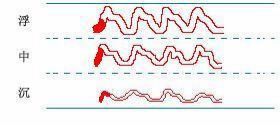▼ The most authoritative knowledge of traditional Chinese medicine is found in reading TCM ▼ Spend time reading
Spend time reading


Editor’s Introduction
Pulse diagnosis is one of the most important methods in clinical diagnosis in TCM, and the difficulty of learning pulse diagnosis is widely recognized in the field. Even the founder of pulse theory, Wang Shuhe, expressed the sentiment that “the chest is clear, but the fingers are hard to discern.”
To master pulse diagnosis, one must memorize certain pulse formulas. However, the ancient and modern pulse formulas are written in verse, making them difficult to understand due to the hidden meanings that are not easily grasped by the unlearned. Therefore, detailed annotations, translations, and explanations of pulse formulas are greatly beneficial for learners. Today, I will guide you through the floating (yang) pulse as described in the “Binhuh Pulse Theory”. Trust me, this content is not difficult to understand, so let’s get started—
 Floating (Yang) Pulse Poem
Floating (Yang) Pulse Poem
[Original Text]
The floating pulse only travels above the flesh, like gently following the elm pods, light as feathers. In autumn, seeing the floating pulse indicates no illness; for those with chronic illness, encountering it may be alarming.
[Summary]
This section discusses the characteristics of the floating pulse.
[Notes]
① Only: merely, just.
② Following: refers to gently pressing or stroking. Here it means lightly pressing or taking.
③ Elm pods: refers to elm seeds.
④ Season: refers to autumn.
⑤ Illness: refers to disease.
 [Translation]
[Translation]
The floating pulse is only present at the surface of the skin, and the sensation under the fingers feels like gently touching elm pods or feathers. In autumn, the presence of a floating pulse indicates no illness; however, for those with chronic conditions, the appearance of a floating pulse may indicate a serious condition that requires attention.
The formation of the floating pulse is often due to external pathogens invading the muscle surface, while the body’s defensive Yang energy resists the external pathogens, causing the Yang energy to rise and manifest at the surface. Therefore, the floating pulse is superficial, and light pressure is sufficient to feel it. If a person with a chronic illness presents with a floating pulse, it is necessary to consider whether there is severe depletion of Qi and blood, with significant damage to Yang energy, indicating a danger of Yang energy rising and failing to remain internal, resulting in a floating pulse that is large and weak.
 【Analysis】
【Analysis】

(II) Similar Pulse Poem
[Original Text]
Floating like wood floating in water, a large hollow pulse is called Kou①. A strong pulse is a Hong pulse, while its departure is slow and gentle③.
The floating pulse is light and flat like twisting scallions④, weak and slow indicates a large hollow⑤. A floating and soft pulse is called Ru, scattered like willow fluff with no fixed trace.
[Summary]
This section discusses the distinguishing features of pulses similar to the floating pulse.
[Notes]
① Kou: refers to a type of floating pulse that is large and hollow.
② Strong pulse: refers to a pulse that beats powerfully.
③ Slow: refers to a gentle and unhurried pulse.
④ Twisting: refers to pressing.
⑤ Hollow: refers to an open and weak pulse.
 [Translation]
[Translation]
The floating pulse resembles wood floating in water; a large hollow pulse is called Kou pulse; a strong pulse is a Hong pulse, which comes in with great force but departs gently. The floating pulse is light and flat, similar to twisting scallions; if it is weak and slow, it indicates a large hollow pulse; if it is floating and soft, it is called Ru pulse; if it is scattered, the pulse is large and dispersed, resembling falling willow fluff, with an irregular rhythm and unpredictable movement.
Similar pulses to the floating pulse include: Hong pulse, Xu pulse, Ru pulse, and San pulse. Generally, a “floating” pulse is like a piece of wood floating on the water, moving gently. If the pulse is large and somewhat heavy but feels hollow in the middle, it is called a “Kou” pulse. Li Ming Shou in “Essentials of Pulse Diagnosis” states: “Like twisting scallion leaves, it resembles a Kou pulse.” Later physicians also often use “scallion leaves” to describe Kou pulse, indicating that the Kou pulse has less blood and is hollow; if the pulse is floating and beats powerfully, it is called a “Hong” pulse. The Hong pulse feels strong when it comes but weakens as it goes. A normal “floating” pulse is relatively light and calm, like twisting scallions, with moderate strength. If the pulse is floating but beats slowly, feeling somewhat large yet hollow and weak, it is called a “Xu” pulse; if the pulse is floating, soft, and small, it is called a soft pulse (Ru pulse); if the pulse comes and goes without a clear root, resembling scattered willow fluff, it is called a “San” pulse.
 【Analysis】
【Analysis】

(III) Main Disease Poem
[Original Text]
The floating pulse indicates Yang surface diseases, with slow pulse indicating wind and rapid pulse indicating heat, while tight pulse indicates cold binding.
[Summary]
This section discusses the main diseases associated with the floating pulse.
[Notes]
① Located: refers to the position.
② Cold binding: refers to the restriction and constraint caused by cold pathogens.
 [Translation]
[Translation]
The floating pulse is primarily associated with Yang pulse diseases. A slow floating pulse often indicates wind, while a rapid floating pulse indicates heat on the surface, and a tight floating pulse indicates cold binding. The floating pulse appears in the superficial layer of the muscles, and it can be felt without applying much pressure. In clinical diagnosis, the key is to distinguish between strong and weak pulses. A strong pulse often indicates the presence of wind, cold, phlegm, or heat pathogens; a weak pulse indicates Qi and blood deficiency. Therefore, while the floating pulse is often associated with surface conditions, it does not mean that every surface condition will present with a floating pulse, nor does every floating pulse indicate a surface condition. Clinically, it is essential to analyze the patient’s constitution, the depth of the illness, and the nature of the pathogenic factors in detail.
 【Analysis】
【Analysis】

(IV) Division Poem
[Original Text]
If the floating pulse is found in the cun position, it often indicates headaches and dizziness, or the presence of wind-phlegm in the chest. If the floating pulse is found in the guan position, it often indicates spleen deficiency and liver excess, with left guan indicating excess liver Yang and right guan indicating weakened spleen Qi. If the floating pulse is found in the chi position, it indicates kidney Qi deficiency, which may lead to urinary issues.
[Summary]
This section discusses the main diseases associated with the floating pulse in the cun, guan, and chi positions.
[Notes]
① Dizziness: refers to the symptom of vertigo.
② Guan position: refers to the guan pulse, which is located at the radial styloid process.
③ Spleen deficiency and liver excess: refers to liver excess and spleen deficiency.
④ Urinary issues: refers to both urination and defecation.
 [Translation]
[Translation]
If the floating pulse is found in the cun position, it often indicates headaches and dizziness, or the presence of wind-phlegm in the chest. If the floating pulse is found in the guan position, it often indicates spleen deficiency and liver excess. A floating pulse in the left guan indicates excess liver Yang, while in the right guan, it indicates weakened spleen Qi. A floating pulse in the chi position indicates kidney Qi deficiency, which may lead to urinary issues.
The cun, guan, and chi positions can be used to diagnose conditions in the upper, middle, and lower jiao. Therefore, if wind pathogens are present in the upper jiao, disturbing the clear orifices, headaches and dizziness may occur. If wind-heat and phlegm obstruct the chest, the Qi mechanism in the upper jiao may be impeded, leading to a floating pulse in the cun position. The spleen and stomach belong to the middle jiao; if spleen Qi is weak and unable to promote movement, and is further affected by liver Qi, the floating pulse is often found in the guan position. The kidneys and bladder belong to the lower jiao; if kidney Qi is insufficient and bladder Qi transformation is impaired, leading to urinary issues, the floating pulse is often found in the chi position.
 [Analysis]
[Analysis]
Recommended Reading

Detailed Annotations and Translations of Binhuh Pulse Theory
“Binhuh Pulse Theory” is a specialized work on pulse theory compiled by Li Shizhen in the Ming Dynasty, written in 1564. The book is divided into two parts: the first part consists of “Seven-Character Verses” that detail 27 pulse types, including floating, sinking, slow, rapid, etc., each described through body condition poems, similar pulse poems, main disease poems, and division poems. The second part consists of “Four-Character Verses,” which were edited and supplemented by his father, Li Yanwen (styled Ziyu, alias Yuechi), based on the “Purple Void Pulse Formula” by Cui Jiayan from the Song Dynasty. “Binhuh Pulse Theory” systematically summarizes pulse types, pulse principles, pulse methods, pulse forms, pulse patterns of the five organs, women’s and children’s pulses, and the significance of true organ pulses. The original text uses verse form, is well-structured, and the content is clinically relevant, making it easy to read and memorize. Since its publication, this book has been valued and praised by physicians throughout history, playing a crucial role in promoting the development of TCM pulse theory and clinical practice. This book is suitable for professionals studying TCM diagnostic methods and beginners as a reference for entry-level guidance.

Scan the QR code to preview Binhuh Pulse Theory
END
Copyright Statement
Some content of this article is selected from “Binhuh Pulse Theory—Detailed Annotations and Translations” (published by China Traditional Chinese Medicine Press, edited by Xue Feifei), and the final interpretation rights belong to the original author. Published by Yue Reading TCM (WeChat ID: ydzongyi), with cover images sourced from the internet. Unauthorized reproduction is prohibited!

 Click “Read the original text” to purchase the printed version of this article
Click “Read the original text” to purchase the printed version of this article

